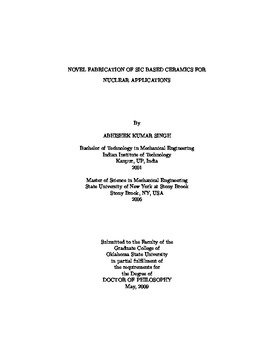| dc.contributor.advisor | Singh, Raman Pal | |
| dc.contributor.author | Singh, Abhishek Kumar | |
| dc.date.accessioned | 2013-12-10T18:05:22Z | |
| dc.date.available | 2013-12-10T18:05:22Z | |
| dc.date.issued | 2009-05 | |
| dc.identifier.uri | https://hdl.handle.net/11244/7819 | |
| dc.description.abstract | Advances in nuclear reactor technology and the use of gas-cooled fast reactors require the development of new materials that can operate at the higher temperatures expected in these systems. These materials include refractory alloys based on Nb, Zr, Ta, Mo, W, and Re; ceramics and composites such as SiC-SiC f; carbon-carbon composites; and advanced coatings. Besides the ability to handle higher expected temperatures, effective heat transfer between reactor components is necessary for improved efficiency. Improving thermal conductivity of the fuel can lower the center-line temperature and, thereby, enhance power production capabilities and reduce the risk of premature fuel pellet failure. | |
| dc.description.abstract | Crystalline silicon carbide has superior characteristics as a structural material from the viewpoint of its thermal and mechanical properties, thermal shock resistance, chemical stability, and low radioactivation. Therefore, there have been many efforts to develop SiC based composites in various forms for use in advanced energy systems. In recent years, with the development of high yield preceramic precursors, the polymer infiltration and pyrolysis (PIP) method has aroused interest for the fabrication of ceramic based materials, for various applications ranging from disc brakes to nuclear reactor fuels. The pyrolysis of preceramic polymers allow new types of ceramic materials to be processed at relatively low temperatures. The raw materials are element-organic polymers whose composition and architecture can be tailored and varied. | |
| dc.description.abstract | The primary focus of this study is to use a pyrolysis based process to fabricate a host of novel silicon carbide-metal carbide or oxide composites, and to synthesize new materials based on mixed-metal silicocarbides that cannot be processed using conventional techniques. Allylhydridopolycarbosilane (AHPCS), which is an organometal polymer, was used as the precursor for silicon carbide. Inert gas pyrolysis of AHPCS produces near-stoichiometric amorphous silicon carbide ( a -SiC) at 900-1150C. Results indicated that this processing technique can be effectively used to fabricate various silicon carbide composites with UC and UO2 as the nuclear component. | |
| dc.format | application/pdf | |
| dc.language | en_US | |
| dc.rights | Copyright is held by the author who has granted the Oklahoma State University Library the non-exclusive right to share this material in its institutional repository. Contact Digital Library Services at lib-dls@okstate.edu or 405-744-9161 for the permission policy on the use, reproduction or distribution of this material. | |
| dc.title | Novel fabrication of SiC based ceramics for nuclear applications | |
| dc.contributor.committeeMember | Apblett, Allen | |
| dc.contributor.committeeMember | Lu, Hongbing | |
| dc.contributor.committeeMember | Kalkan, A. Kaan | |
| osu.filename | Singh_okstate_0664D_10269.pdf | |
| osu.accesstype | Open Access | |
| dc.type.genre | Dissertation | |
| dc.type.material | Text | |
| dc.subject.keywords | ahpcs | |
| dc.subject.keywords | mixed-metal carbide | |
| dc.subject.keywords | nuclear fuel | |
| dc.subject.keywords | polymer infiltration and pyrolysis | |
| dc.subject.keywords | silicon carbide | |
| dc.subject.keywords | uranium oxide | |
| thesis.degree.discipline | Mechanical Engineering | |
| thesis.degree.grantor | Oklahoma State University | |
